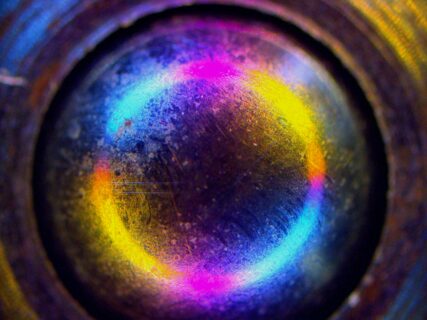January 2024

Our group investigates PVD and CVD coatings with special focus on crystalline CVD-Diamond layers. This includes the design of coating machines, process optimisation and characterisation of the produced coating systems. A key factor of coating quality is the adhesion that marks the ability of the layer to withstand mechanical impact on the coated part. This property is especially significant for applications were the mechanical loading is high and a good coating adhesion yields a long lifetime, e.g. in drills, end-face mechanical seals or aluminium die-casting tools. However, also other diamond coated parts profit from a stable layer adhesion, be it BDD-electrodes, spot-welding caps or diamond coated implants.
To characterise the adhesion quality of a given sample, an indenter as shown in the image, a 100Cr6 Brinell indenter, is pressed into the sample with a defined force and the delamination of the coating is evaluated by area, distribution and location. From parameter studies, optimisation approaches can be deduced, such as different pretreatment steps, adaption of surface roughness or improved process parameters. This allows us the coating of different substrate materials like steels, cemented carbide or titanium for various applications with a well-adhesive, crystalline diamond coating.
Link to Research Group:
Materials Science and Engineering for Metals – Ultra-hard Coatings
Example Publications:
https://doi.org/10.1016/j.diamond.2023.109931
https://doi.org/10.1021/acsenergylett.1c00904
Helmreich, T., Göltz, M., Mengele, T., & Rosiwal, S. (2020). CVD-Diamant als Schutzschicht im Aluminiumguss. Gießerei-Praxis, 5-6, 32-34.
